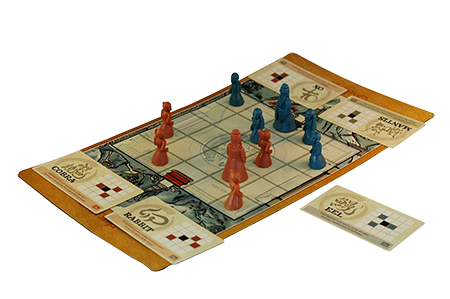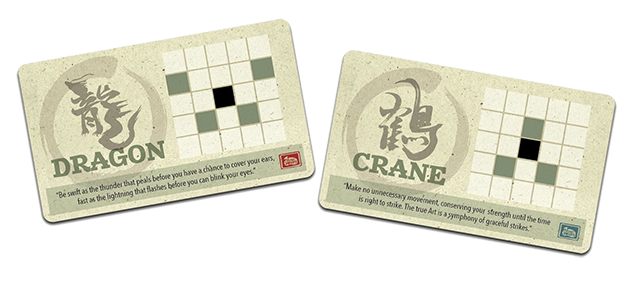At first glance, you might consider Onitama to be Chess for simpletons. There are fewer pieces, a smaller play area and simple rules. But as easy and quick as it is to learn, beneath the surface lies a game which is not just beautiful in looks and simplicity, but one that also has a hidden depth which belies its size.
Components
I am a sucker for a nice game-box, and Onitama has a beautiful box. Themed around the mythical Shrine of Onitama, where students learn to become masters of Martial Arts, the box is decorated in the muted colours and style of traditional Japanese paintings.
The shape, similar to a presentation box for a bottle of port or whisky, means it won’t slot easily onto a shelf with other, more traditionally packaged games. But who cares when it is as lovely as this? It has a magnetic clasp to keep it securely closed, and the outer layer unwraps to reveal the secrets within.
Inside are more things of beauty; a neoprene play mat; two sets of pawns, in blue and red – one Master and four students each; a set of 16 cards, and a very thin rule book.
Gameplay...
Set the play mat between players. It is a 5 x 5 grid where the centre-square closest to each player is decorated with a Temple Arch. Place the Master Pawn on the Temple Arch, and the remaining pawns on the other squares in the back row.
The aim of the game is to capture your opponent’s Master or take possession of their Temple Arch. Easy! But therein lies the interesting/clever/frustrating beauty of the game. Unlike chess, none of the pawns have a prescribed way of moving. The deck of 16 cards drives this part of the game.
Shuffle the cards, draw two cards each and lay them face up in front of you. Then draw a fifth card and place it to the side of the play-mat.
...And the cards
Beautifully illustrated and featuring calligraphic representations of various creatures including the Dragon, Rabbit, Cobra, and Crab, each card offers a different and specific way to move your pawns.
The cards show one square highlighted in black. This represents the square occupied by any given pawn. Around this square, a number of other highlighted squares show where the chosen pawn can move, relative to its current position. You can move any one of your pawns to any of the highlighted squares from your current square. The move can take your pawn forwards, sideways, and even backwards.
And now for the clever part:
The active player decides which card they want to use to affect a move, and with which pawn. After moving, they swap that card with the card sitting in the middle of the table. This means that the card just played will go to your opponent after they play and move next time. So not only do you need to consider your next move, you also need to think about the card you will be making available to your opponent for a future turn. And of course what you might get in return next time.
For players who suffer from Analysis Paralysis, this can cause their brains to implode. Choices are limited, each one is important, and they are all there on the table for both players to see! Sometimes you know what's coming, you know it is bad (or good!), and you just hope your opponent has missed it.
A move results in either occupying an empty square or landing on a square occupied by an opponent's pawn, which is then removed from the game. Play alternates until the Master is captured or you fashion a way to land on your opponent's Temple Arch.
Final Thoughts on Onitama
For such a small and simple game Onitama offers a deep and satisfying playing experience. Games range from two minutes to 20 minutes. Arguably everything is subject to the vagaries of the random draw of cards, but this is part of the appeal. Each game presents both players with the same new possibilities, where the cards you hold but have to give away are as dangerous to you as they are to your opponent.
Game time might suggest this is just a filler, but if you channel your Chi and the power of the Cobra it is so, so much more than that.







